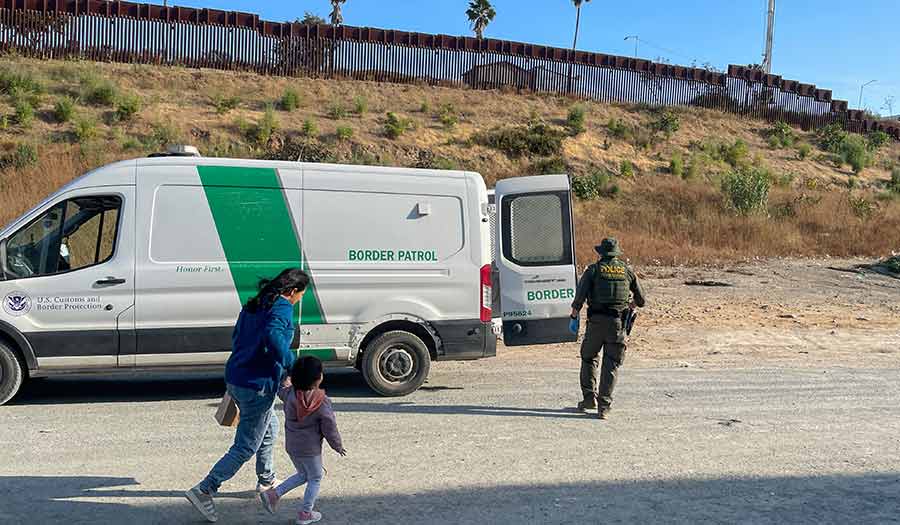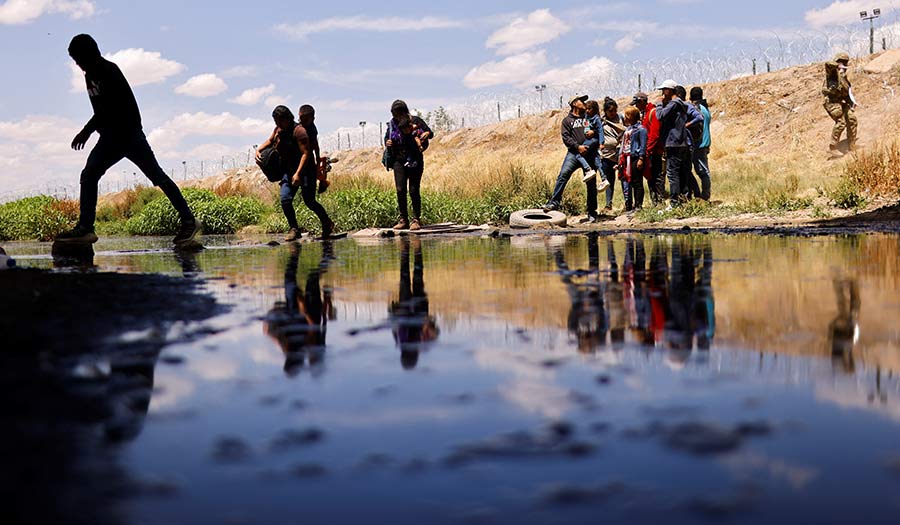 REUTERS/Daniel Trotta
REUTERS/Daniel Trotta
World News Desk
Learn the why behind the headlines.
Subscribe to the Real Truth for FREE news and analysis.
Subscribe NowSAN DIEGO (Reuters) – Jessica Leon, an asylum-seeker from Ecuador, scaled a border wall on Tuesday with her 3-year-old daughter, setting foot on U.S. soil in San Diego, California, just hours before a new asylum ban took effect.
She and about a dozen other migrants from Guatemala, Colombia and Vietnam who climbed the wall immediately turned themselves in to U.S. border agents. They were directed to walk to the place known as Whiskey 8—a dusty strip of U.S. territory between two border walls, one dividing the U.S. from Mexico and the second a more imposing obstacle several yards further north.
The open-air detention site has become a symbol of the chaotic U.S. asylum process, which U.S. President Joe Biden says is in desperate need of reform. In a sweeping executive action announced Tuesday, Mr. Biden implemented an asylum ban that allows U.S. immigration officials to quickly deport migrants who cross illegally to their home countries or to turn them back to Mexico.
Immigrant advocates criticized Mr. Biden’s move, saying it mirrored hardline actions of his Republican predecessor former President Donald Trump as the two are facing a rematch in the November 5 election.
The American Civil Liberties Union said it planned to sue over Mr. Biden’s measures.
Ms. Leon and her daughter arrived just hours before the policy took effect at 12:01 a.m. EDT Wednesday, or 9:01 p.m. Tuesday in San Diego.
Some asylum-seekers gravitate to Whiskey 8 on their own. Others who have been detained by the Border Patrol elsewhere between the two walls are dropped off there, or directed to walk there, for subsequent processing.
It remained uncertain on Wednesday how long the Whiskey 8 routine would continue. Aid workers said a group of 85 migrants gathered there anew on Wednesday morning, despite the ban taking effect.
Like many lined up in Tijuana, Mexico, waiting to cross Tuesday, migrants who apply to approach a legal port of entry through a government-run cell phone app will still be allowed to enter.
‘All by Myself’
Having spent her last $3,000 on a month-long overland journey from Ecuador, Leon, a 28-year-old house cleaner, said she hoped for a better life for her daughter.
“I’m all by myself with her,” she said, peering down at her daughter and breaking into tears during in a brief interview conducted between the bollards of a 30-foot border fence.
At Whiskey 8, so-named by the Border Patrol, people have access to aid workers, immigration lawyers and journalists who may gather on the other side. The border wall bollards are spaced far enough apart to talk, deliver food and water, or charge a phone, but too close together for a human to pass.
Asked why she fled her home in the Andean city of Cuenca, Leon mentioned the criminal climate—”they kill, they rob, they extort.”
U.S. asylum law requires proof of persecution due to race, religion, nationality, membership in a particular social group, or political opinion, with cases usually decided by an immigration judge.
Mr. Biden’s new policy raises the bar for initial asylum screenings for migrants like Leon, which could lead to more claims being rejected sooner, or some people being denied outright if they fail to express fear of return.
In his presidential proclamation justifying the move, Mr. Biden said during a recent 5-year period, 83 percent of asylum-seekers passed through the initial screening stage but less than 25 percent were ultimately granted asylum or other protection and often after waiting years to reach a final decision due to immigration court backlogs.
Under the new rule, the minimum time asylum-seekers have to find a lawyer is slashed to four hours from 24 hours previously, two U.S. Department of Homeland Security (DHS) officials said, who spoke on condition of anonymity to discuss government operations.
The aim is to screen almost all migrants faster—possibly in under a week—and migrant families could end up being held in tent facilities near the border while their deportation cases are being evaluated, one of the DHS officials said.
San Diego has become a top entry point for migrants from all over the world in recent months, putting strains on border agents and immigration service providers.
Migrants who cross illegally elsewhere in the San Diego area have gathered at several makeshift sites in recent months to wait for Border Patrol agents to pick them up for processing.
Among those at Whiskey 8 on Tuesday was Jairon Lopez, 26, a moto-taxi driver from Guatemala. He, too, said he was seeking a better life after fleeing extortion from gangs in the town of Chiquimulilla.
“It’s like that saying, ‘Plata o plomo.’ They say that in Guatemala now,” Mr. Lopez said of a phrase that translates roughly as “your money or your life.”
So he hitchhiked through Mexico, arriving at Whiskey 8 just hours before Mr. Biden’s deadline loomed.
To learn what is behind this, read Why Do Migrants Want to Be in America?
- Real Truth Magazine Articles
- AMERICAS
 Why Do Migrants Want to Be in America?
Why Do Migrants Want to Be in America?
More on Related Topics:
- Suicides in the U.S. Military Increased in 2023, Continuing a Long-term Trend
- Masses Flee Homes in Haiti as Gangs Ratchet Up Violence amid Political Turmoil
- Haiti Sees a Rise in Killings and Police Executions with Children Targeted, UN Says
- Thousands Survived a Brutal Gang Attack in Haiti that Killed 70. Now They Face an Uncertain Future
- Hunger in Haiti Reaches Famine Levels as Gangs Squeeze Life Out of the Capital and Beyond


